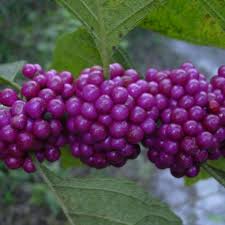Beautyberry a rapidly-growing North American native forms a rather loosely-arranged, rounded shrub, five to eight feet tall and equally wide (Fig. 1). Branches form long arches bending toward the ground and lend almost a weeping habit to older, established shrubs. The coarse, fuzzy, light green, deciduous leaves are combined with small, lavender-pink blossoms densely clustered in leaf axils from June through August. A profusion of very showy, 1/3-inch-diameter, clustered berries follow, densely packed and encircling the woody stems. These shiny purple-blue fruits are quite attractive to birds and, if not completely devoured, will persist on the stems for several weeks after the leaves drop.
General Information
Scientific name: Callicarpa americana
Pronunciation: kal-lick-AR-puh uh-mair-rick-KAY-nuh
Common name(s): American beautyberry, American mulberry
Family: Verbenaceae
Plant type: shrub
USDA hardiness zones: 7 through 11 (Fig. 2)
Planting month for zone 7: year round
Planting month for zone 8: year round
Planting month for zone 9: year round
Planting month for zone 10 and 11: year round
Origin: native to Florida
Uses: foundation; border; mass planting; container or aboveground planter; naturalizing
Availability: somewhat available, may have to go out of the region to find the plant
Description
Height: 3 to 8 feet
Spread: 4 to 8 feet
Plant habit: round; spreading; vase shape
Plant density: open
Growth rate: moderate
Texture: medium
Foliage
Leaf arrangement: opposite/subopposite
Leaf type: simple
Leaf margin: serrate
Leaf shape: ovate
Leaf venation: pinnate
Leaf type and persistence: fragrant
Leaf blade length: 4 to 8 inches
Leaf color: green
Fall color: yellow
Fall characteristic: not showy
Flower
Flower color: lavender
Flower characteristic: spring flowering
Fruit
Fruit shape: round
Fruit length: less than .5 inch
Fruit cover: fleshy
Fruit color: purple
Fruit characteristic: persists on the plant; attracts birds
Trunk and Branches
Trunk/bark/branches: not particularly showy; typically multi-trunked or clumping stems
Current year stem/twig color: green
Current year stem/twig thickness: medium
Culture
Light requirement: plant grows in part shade/part sun
Soil tolerances: acidic; slightly alkaline; sand; loam; clay
Drought tolerance: moderate
Soil salt tolerances: poor
Plant spacing: 36 to 60 inches
Other
Roots: usually not a problem
Winter interest: no special winter interest
Outstanding plant: not particularly outstanding
Invasive potential: may self-seed each year
Pest resistance: no serious pests are normally seen on the plant
Use and Management
Its ease of maintenance and popularity with birds makes American beautyberry especially useful for the naturalized garden where it blends in well with pines, oaks, and darker leaved shrubs. Appearing best when massed together, American beautyberry can also be used as a screen or specimen. Allow plenty of room for this large, sprawling shrub unless regular pruning can be provided to control its size. The thinning-type pruning method works best for beautyberry since regular shearing removes flowers and developing fruits.
American beautyberry is relatively maintenance free and grows easily in full sun or light, dappled shade on a variety of soils. Old wood should be pruned heavily in late fall to early spring since flowers and fruit are produced on new growth.
Callicarpus americana var. lactea has white berries and attractive foliage. The cultivar ‘Russell Montgomery’ has especially nice white berries.
Propagation is by seed or softwood cuttings.
Pests and Diseases
No pests are of major concern. Caterpillars may occasionally chew the leaves.
No diseases are of major concern.


